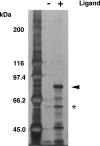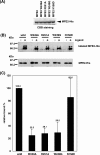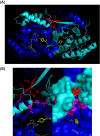Identification of a substrate-binding site in a peroxisomal beta-oxidation enzyme by photoaffinity labeling with a novel palmitoyl derivative
- PMID: 20566640
- PMCID: PMC2924054
- DOI: 10.1074/jbc.M110.104547
Identification of a substrate-binding site in a peroxisomal beta-oxidation enzyme by photoaffinity labeling with a novel palmitoyl derivative
Abstract
Peroxisomes play an essential role in a number of important metabolic pathways including beta-oxidation of fatty acids and their derivatives. Therefore, peroxisomes possess various beta-oxidation enzymes and specialized fatty acid transport systems. However, the molecular mechanisms of these proteins, especially in terms of substrate binding, are still unknown. In this study, to identify the substrate-binding sites of these proteins, we synthesized a photoreactive palmitic acid analogue bearing a diazirine moiety as a photophore, and performed photoaffinity labeling of purified rat liver peroxisomes. As a result, an 80-kDa peroxisomal protein was specifically labeled by the photoaffinity ligand, and the labeling efficiency competitively decreased in the presence of palmitoyl-CoA. Mass spectrometric analysis identified the 80-kDa protein as peroxisomal multifunctional enzyme type 2 (MFE2), one of the peroxisomal beta-oxidation enzymes. Recombinant rat MFE2 was also labeled by the photoaffinity ligand, and mass spectrometric analysis revealed that a fragment of rat MFE2 (residues Trp(249) to Arg(251)) was labeled by the ligand. MFE2 mutants bearing these residues, MFE2(W249A) and MFE2(R251A), exhibited decreased labeling efficiency. Furthermore, MFE2(W249G), which corresponds to one of the disease-causing mutations in human MFE2, also exhibited a decreased efficiency. Based on the crystal structure of rat MFE2, these residues are located on the top of a hydrophobic cavity leading to an active site of MFE2. These data suggest that MFE2 anchors its substrate around the region from Trp(249) to Arg(251) and positions the substrate along the hydrophobic cavity in the proper direction toward the catalytic center.
Figures









Similar articles
-
Regulation of peroxisome size and number by fatty acid beta -oxidation in the yeast yarrowia lipolytica.J Biol Chem. 2000 Jun 30;275(26):20168-78. doi: 10.1074/jbc.M909285199. J Biol Chem. 2000. PMID: 10787422
-
Gene expression of peroxisomal beta-oxidation enzymes in rat brain.Brain Res Mol Brain Res. 1999 Dec 10;74(1-2):217-20. doi: 10.1016/s0169-328x(99)00252-1. Brain Res Mol Brain Res. 1999. PMID: 10640693
-
A novel HPLC-based method to diagnose peroxisomal D-bifunctional protein enoyl-CoA hydratase deficiency.J Lipid Res. 2003 Mar;44(3):640-4. doi: 10.1194/jlr.D200039-JLR200. Epub 2002 Dec 1. J Lipid Res. 2003. PMID: 12562856
-
Peroxisomes and beta-oxidation of long-chain unsaturated carboxylic acids.Scand J Clin Lab Invest Suppl. 1991;204:33-46. doi: 10.3109/00365519109104593. Scand J Clin Lab Invest Suppl. 1991. PMID: 2042025 Review.
-
Lessons from knockout mice II: Mouse models for peroxisomal disorders with single protein deficiency.Adv Exp Med Biol. 2003;544:123-34. doi: 10.1007/978-1-4419-9072-3_17. Adv Exp Med Biol. 2003. PMID: 14713223 Review. No abstract available.
Cited by
-
Photo-affinity labelling and biochemical analyses identify the target of trypanocidal simplified natural product analogues.PLoS Negl Trop Dis. 2017 Sep 5;11(9):e0005886. doi: 10.1371/journal.pntd.0005886. eCollection 2017 Sep. PLoS Negl Trop Dis. 2017. PMID: 28873407 Free PMC article.
-
On the molecular basis of D-bifunctional protein deficiency type III.PLoS One. 2013;8(1):e53688. doi: 10.1371/journal.pone.0053688. Epub 2013 Jan 7. PLoS One. 2013. PMID: 23308274 Free PMC article.
-
Multisite Labeling of Proteins Using the Ligand-Directed Reactivity of Triggerable Michael Acceptors.Bioconjug Chem. 2023 Jun 21;34(6):1130-1138. doi: 10.1021/acs.bioconjchem.3c00155. Epub 2023 May 23. Bioconjug Chem. 2023. PMID: 37220065 Free PMC article.
-
Photoaffinity labeling in target- and binding-site identification.Future Med Chem. 2015;7(2):159-83. doi: 10.4155/fmc.14.152. Future Med Chem. 2015. PMID: 25686004 Free PMC article. Review.
-
Clicking on trans-translation drug targets.Front Microbiol. 2015 May 19;6:498. doi: 10.3389/fmicb.2015.00498. eCollection 2015. Front Microbiol. 2015. PMID: 26042115 Free PMC article. No abstract available.
References
-
- Wanders R. J., Waterham H. R. (2006) Annu. Rev. Biochem. 75, 295–332 - PubMed
-
- Lazarow P. B., Moser H. W. (1995) The Metabolic and Molecular Basis of Inherited Disease, pp. 2287–2324, McGraw-Hill Inc., New York
-
- Fujiki Y. (2000) FEBS Lett. 476, 42–46 - PubMed
-
- Wanders R. J., Waterham H. R. (2006) Biochim. Biophys. Acta 1763, 1707–1720 - PubMed
Publication types
MeSH terms
Substances
LinkOut - more resources
Full Text Sources
Molecular Biology Databases
Research Materials

